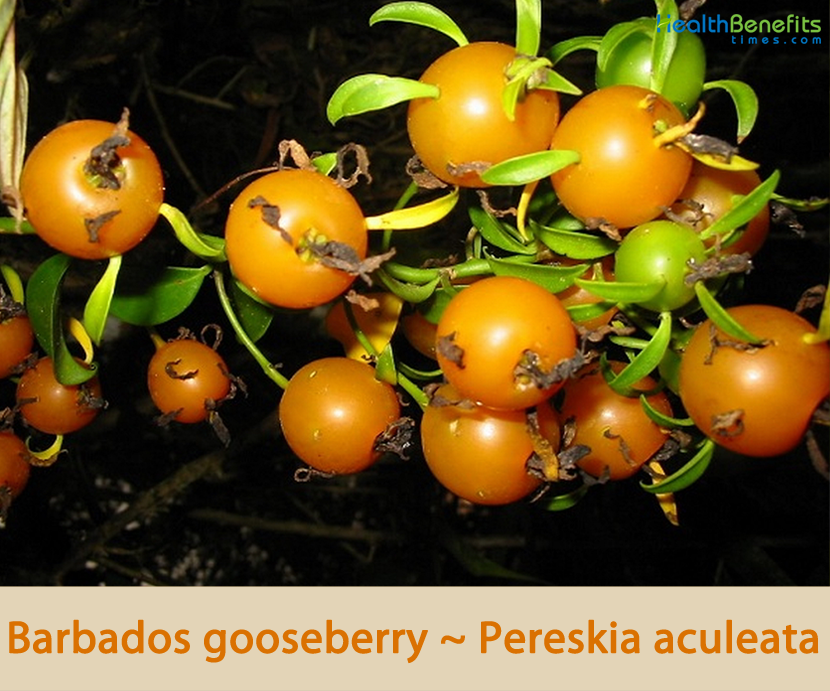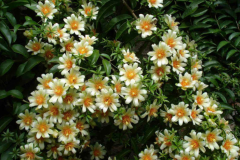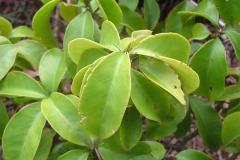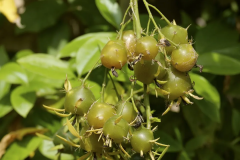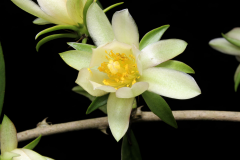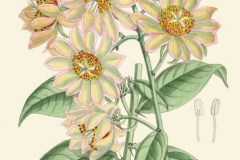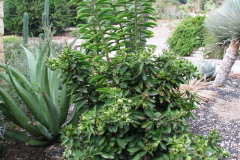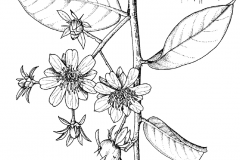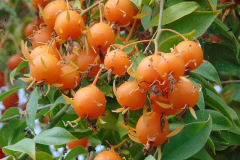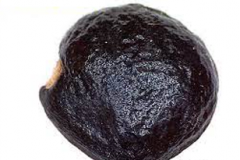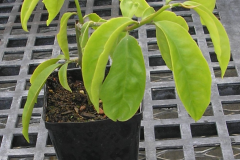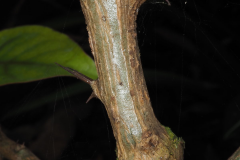| Barbados gooseberry Quick Facts | |
|---|---|
| Name: | Barbados gooseberry |
| Scientific Name: | Pereskia aculeata |
| Origin | Central America (i.e. Panama), the Caribbean and South America (i.e. French Guiana, Guyana, Surinam, Venezuela, Brazil, Colombia, Argentina and Paraguay). |
| Colors | Start off in a green hue that becomes yellow and eventually turns orange when they are ripe. |
| Shapes | Fleshy, round, oval or pyriform berry that is 15-45 mm across |
| Taste | Juicy and quite tart in taste |
| Health benefits | Boost the immune system, enhance vision, fights tumor cells, treats inflammation, headaches, ulcers, hemorrhoids, dermatitis, general pain and rheumatism |
| Name | Barbados gooseberry |
|---|---|
| Scientific Name | Pereskia aculeata |
| Native | Central America (i.e. Panama), the Caribbean and South America (i.e. French Guiana, Guyana, Surinam, Venezuela, Brazil, Colombia, Argentina and Paraguay). Occasionally it naturalized in the coastal districts of eastern Australia (i.e. in south-eastern and northern Queensland and the coastal districts of northern and central New South Wales). It also naturalized overseas in southern Africa, Mexico and southern USA (i.e. Texas and Florida). |
| Common Names | Barbados gooseberry, Barbados shrub, blade apple, blade apple cactus, leaf cactus, leafy cactus, lemon vine, lemonvine, pereskia, pereskia creeper, primitive cactus, rose cactus, Spanish gooseberry, Surinam gooseberry, Sweet Mary, Gooseberry shrub, West Indian gooseberry, White Bougainvillea, ora-pro-nobis |
| Name in Other Languages | Afrikaans: Barbados kruisbes Albanian: Barishte barishte Amharic: Baribadosi yegēt’agēt’i fire (ባርባዶስ የጌጣጌጥ ፍሬ) Arabic: Eanb barbadus (عنب بربادوس) Armenian: Barbados sagi (բարբադոս սագի) Azerbaijani: Barbados qarğıdalı Bengali: Bārbāḍōsa gujabēri (বার্বাডোস গুজবেরি) Bulgarian: Barbados tsarigradsko grozde (барбадос цариградско грозде) Burmese: ဆီးဖြူ Barbados-seehpyauu Barbados Chinese: Bābāduōsī cù lì (巴巴多斯醋栗), Yè xiānrénzhǎng (叶仙人掌V Filipino: Barbados gooseberry Finnish: Barbadoksen karviaismarja, puukaktus, French: Groseille de Barbade, Groseillier des Barbades, Cactus à feuilles, Godseffiana, Péreskia épineux, groseillier des Antilles Georgian: Barbados gooseberry German: Barbados Stachelbeere, stacheliger Laubkaktus Greek: Frankostáfylo Barmpántos (φραγκοστάφυλο Μπαρμπάντος) Gujarati: Bārbāḍōjha gūsabērī (બાર્બાડોઝ ગૂસબેરી) Hausa: Barbados guzberi Hebrew: דובדבן ברבדוס Hindi: Baarabados goose (बारबडोस गूसे) Hungarian: Barbados egres Icelandic: Barbados garðaber Indonesian: Barbados gooseberry Irish: SpíonÚn barbadós Italian: Uva spina barbados Japanese: Barubadosugūzuberī (バルバドスグーズベリー), Mokukirin (杢キリン), Mokukirin (もくきりん) Javanese: Barbados gooseberry Kannada: Bārbaḍōs nellikāyi (ಬಾರ್ಬಡೋಸ್ ನೆಲ್ಲಿಕಾಯಿ) Kazakh: Barbados qarlığan (барбадос қарлыған) Korean: Babeidoseu guseubeli (바베이도스 구스베리), moggilinseon-injang (목기린선인장) Kurdish: Barbados gozelok Lao: Gooseberry barbados Latin: Barbados hominem Latvian: Barbadosas ērkšķogu Lithuanian: Barbadoso agrastas, Dygliuotoji pereskija Macedonian: Tsarigradsko grozde (цариградско грозде) Malagasy: Barbados gooseberry Malay: Barbados gooseberry Malayalam: Bārbaḍēās nellikka (ബാർബഡോസ് നെല്ലിക്ക) Maltese: Barbados tal-wiżż Marathi: Bārbāḍōsa hiravī phaḷē yēṇārē ēka jhāḍa (बार्बाडोस हिरवी फळे येणारे एक झाड) Mongolian: Barbados gooseberry Nepali: Bārbāḍōsa gusabērī (बार्बाडोस गुसबेरी) Norwegian: Barbados stikkelsbær, trekaktus Oriya: ବାରବାଡୋସ୍ ଗୋସ୍ବେରୀ | Pashto: د بارباډوز غوړکی Persian: نگور فرنگی انگور Polish: Agrest barbados Portuguese: Groselha de Barbados, Azedinha, Cipó-santo, Espinho-de-Santo-Antônio, Espinho-preto, Lobolôbô, Ora-pro-nobis, Surucucú, Cipó Santo, Espinho Preto, Espinho de Santo Antonio, Groselha-da-América, Mata velha Punjabi: Bārabāḍō karaudā (ਬਾਰਬਾਡੋ ਕਰੌਦਾ) Romanian: Barbada de coacăze Russian: Barbados krıjovnïk (Барбадос крыжовник), Kaktus-roza (Кактус-роза), Pereskiya shipovataya (Переския шиповатая), Pereskiya akuleata (Переския акулеата), Pereskiya Godseffa (Переския Годсеффа), P. Shipovatotoy (П. Шиповатотой), pereskiya kolyuchaya (переския колючая), pereskiya shipovataya (переския шиповатая) Serbian: Barbados grickalica (барбадос грицкалица) Sindhi: باربيڊوس گوزبيري Sinhala: Bābaḍōs gūsberi (බාබඩෝස් ගූස්බෙරි) Slovenian: Barbados kosmulja Spanish: Grosella espinosa de Barbados, Bugambilia blanca, Camelia blanca, Grosellero, Jasmín de uvas, Ramo de novia, Bledo, Buganvilla blanca, Corona de novia, Grosella de la florida, Grosellero, Guamacho, Horensia de bejuco, Naju de espinas, Guamacho, hortensia de bejuco, uña de bejuco Sundanese: Barbados gooseberry Swedish: Barbados krusbär, Trädkaktus Tajik: Barbad gooseberry Tamil: Pārpaṭōs nellikkāy (பார்படோஸ் நெல்லிக்காய்) Telugu: Bārbaḍōs gūsberrī (బార్బడోస్ గూస్బెర్రీ) Thai: Bār̒bedos̄ maym (บาร์เบโดสมะยม) Turkish: Barbados bektaşi üzümü Ukrainian: Barbados ahrus (барбадос агрус) Urdu: بارباڈوس گوزبیری Uzbek: Barbados krijovnik Vietnamese: Barbados ngỗng Welsh: Eirin Mair barbados Zulu: Barbados ugqumugqumu |
| Plant Growth Habit | Erect woody shrub when young, becoming scrambling or climbing vine like with age |
| Growing Climates | Potential weed of riparian areas, urban bush land, open woodlands, dry forests, rocky areas, grassland, scrubland, tropical hammocks, savanna forests, coastal dunes, roadsides, urban open spaces, rocky areas in mesophytic forest, resting and dunes near the sea and coastal environs in tropical, sub-tropical and warmer temperate regions. |
| Soil | It grows in many soil types and different levels of fertility, preferring deep soils that have good drainage. The plant is drought tolerant and does not do well if over watered. |
| Plant Size | Up to 10 m tall |
| Stem | Stems reach 2-3 cm in diameter. Younger stems have hooked thorns and older stems have clusters of woody spines |
| Leaf | Deciduous, alternate, short-petioled, waxy leaves are elliptic, oblong or ovate, with a short point at the apex; 1 1/4 to 4 in (3.2-10 cm) long, sometimes fleshy |
| Flowering season | In Jamaica, the plant blooms in June and again in October and November |
| Flower | Flowers are lemon-scented; others say sweet and pungent in odor; still others, of unpleasant or repulsive odor. They are borne profusely in panicles or corymbs; are white, yellowish or pink-tinted; 1 to 1 3/4 in (2.5-4.5 cm) across and the calyx tube is prickly |
| Fruit Shape & Size | Fleshy, round, oval or pyriform berry that is 15-45 mm across with thin, smooth, somewhat leathery skin |
| Fruit Color | Start off in a green hue that becomes yellow and eventually turns orange when they are ripe |
| Fruit Skin | Thin, smooth skin |
| Flesh | Soft, juicy, opaque flesh |
| Seed | There are only a few flat, thin, brown or black, soft seeds about 1/6 in (4 mm) long |
| Taste | Juicy and quite tart in taste |
| Plant Parts Used | Leaves, Fruit |
| Propagation | By seed and also vegetatively via its fleshy stems |
| Health Benefits |
|
| Season | March and October |
Plant Description
Barbados gooseberry is an erect woody shrub when young, becoming scrambling or climbing vine like with age. The plant grows up to 10 m high in trees, with stems 2-3 cm thick. Younger stems have hooked thorns and older stems have clusters of woody spines. It is a potential weed of riparian areas, urban bush land, open woodlands, dry forests, rocky areas, grassland, scrubland, tropical hammocks, savanna forests, coastal dunes, roadsides, urban open spaces, rocky areas in mesophytic forest, resting and dunes near the sea and coastal environs in tropical, sub-tropical and warmer temperate regions. The plant grows in many soil types and different levels of fertility, preferring deep soils that have good drainage. The plant is drought tolerant and does not do well if over watered.
Stems
It older stems are woody and bear long and slender clusters of straight spines 1-5 cm long on the branches they are short and curved. Younger stems are fleshy in nature (i.e. succulent) and hairless (i.e. glabrous). They bear one to three smaller spines (3-5 mm long) in the leaf forks (i.e. axils).The stem has a mucilaginous sap. It has the ability to re-grow from pieces of stem and even from detached leaves.
Leaves
The alternately arranged leaves are often clustered towards the tips of the branches. They are somewhat fleshy (i.e. succulent) and are borne on short stalks (i.e. petiols) 3-7 mm long. These leaves are 4-7 cm long and 2-4 cm wide and are oval (i.e. elliptic) or egg-shaped in outline (i.e. obovate) with entire margins and pointed tips (i.e. acute apices). They are often pale green in color, especially when growing in a sunny position, and are smooth and hairless (i.e. glabrous).
Flowers
The semi-transparent white, yellowish or pink-tinted flowers are 25-40 mm across have a sweet and pungent odor and are borne in clusters in the leaf forks or at the tips of the branches (i.e. in axillary ot terminal panicles). The flowers have several leafy projections, and often also some small spines, on their ovaries, which can be easily mistaken for sepals. They have several white or pale yellow ‘petals’ (i.e. perianth segments or tepals) that sometimes turn pale pinkish in colour as they age. Each flower also has numerous stamens that are shorter than the ‘petals’. Flowering occurs mostly during summer.
In Jamaica, the plant blooms in June and again in October and November; fruit mature in March and October. In Brazil, the fruit ripen in August–September. On the warm north coast of Honduras, it tends to produce fruit most of the year. Honeybees and other insects are frequent visitors to the flowers and are believed to be the main pollinating agents.
Fruit
Fertile flowers are followed by fleshy, round, oval or pyriform berry that is 15-45 mm across. Fruits are initially green turning to yellow and then eventually orange in color as they mature. Fruit has a thin, smooth, leathery skin. The curling, leafy sepals of the calyx cover the fruit and fall when the fruit reaches maturity. Few spines are found on the fruit. When fully ripe, the white fruit pulp is juicy with a sub-acid to tart flavor. The fruit are also edible, containing numerous small seeds. Seeds are black, somewhat flattened, 4 to 5 mm in diameter; hilum basal, circular, depressed, or crater-shaped. It somewhat resembles the gooseberry in appearance and is of excellent flavor. Capuchin and brown howler monkeys feed on the fruits, and in some regions of Brazil are its main dispersers.
History
The Barbados gooseberry is supposed to be indigenous to the West Indies, coastal northern South America and Panama. It is seldom found truly wild but is frequently grown as an ornamental or occasionally for its fruits in the American tropics, Bermuda, California, Hawaii, Israel, the Philippines, India and Australia. In many areas it has escaped from cultivation and become thoroughly naturalized. It was growing at the Agricultural Research and Education Center in Homestead in the early 1940’s and running wild to some extent in the Redlands, but has since disappeared, possibly destroyed by winter cold or excessive rainfall. At least one nursery in Winter Haven, Florida, is now growing the plant in quantity. Gardeners had to give up the plant in South Africa in 1979 when it was banned as an illegal weed because it had been invading and overwhelming natural vegetation. It is frequently grown in greenhouses and as a house plant in temperate regions of both hemispheres. Horticulturists often use this species as a rootstock on which to graft other less vigorous cacti.
Health benefits of Barbados gooseberry
Listed below are some of the well-known health benefits of using Barbados gooseberry
1. Antioxidant booster
Barbados gooseberries are packed with high levels of vitamins and minerals, which make them the perfect defense against disease. Their leaves are a great source of folic acid, vitamin A and C, calcium, magnesium and zinc. Their fruits are a significant source of vitamin C, phosphorus and calcium. All these vitamins and minerals are crucial for proper bodily function; from making red blood cells, boosting the immune system, to enhancing your vision, protecting cells from free radicals and preventing chronic diseases.
2. Optimizes intestinal function
This amazing plant is a wonderful source of dietary fiber. Found both in their leaves and fruits, fiber will help you maintain a healthy digestive system. The fiber found in Barbados gooseberry also possesses probiotic benefits and the improvement of intestinal movement and gut health. In a recent trial, when it was used and consumed as flour, it resulted in a reduction of flatulence, beneficial maintenance of intestinal microbiota as well as an increased satiety in participants.
3. Anti-inflammatory
These are not only used as food but also as medicine. Because of its high mucilaginous content, it helps heal the skin from wounds. It also fights tumor cells and treats inflammation due to their high antioxidant profile. Similarly, it can be used as a natural medicine for headaches, ulcers, hemorrhoids, dermatitis, general pain, rheumatism and inflammation.
4. Analgesic strength
Barbados gooseberries also help relieve pain because of their antimicrobial, antifungal and anti-allergic properties. In general, because of their high concentration of caftaric acid, (a non-flavonoid phenolic compound also found in the juice of grapes) free radicals and carcinogenic cells are eliminated.
Traditional uses and benefits of Barbados gooseberry
- In Brazil, the leaves are valued for their softening and soothing nature and are applied on inflammations and tumors.
- Some Pereskia species are reported to be used as natural remedies for headache, inflammation, gastric pain, for pain relief, and as tonics.
- Leaves were used as a natural remedy for pain relief and as tonics to revitalize the body.
Culinary Uses
- The fruit are eaten fresh, stewed, preserved with sugar or made into jam or jelly.
- Pectin needs to be added to make jam and jelly since the fruit is low in pectin and does not gel.
- The young shoots and leaves are cooked and eaten as greens due to their flavor and high (25%) protein content based on dry matter and 85% digestibility.
- In rural Brazil, they are important as food for humans and livestock.
- The leaves can also be cooked and used as a vegetable or dried and crushed to be combined into various dishes such as miso soup, breads, and sausages.
- They can be eaten in salads in the same way as Purslane, or added to cooked dishes and eaten as greens.
Other Facts
- In many temperate countries it is grown as an ornamental cactus in greenhouses or as an indoor plant.
- In other cases it is used, together with its relative Pereskia bleo, as vigor-inducing places, it grows to become an impenetrable fence due to its aggressive spine system.
- In Israel, the flowers are said to be of great value in apiculture.
- Barbados gooseberry has been declared a weed and banned for cultivation in South Africa and Hawaii because of its potential to cause extensive damage to forest areas by smothering indigenous trees.
- The juvenile period is about 3 years from seed and 2 years from cuttings.
References:
https://www.itis.gov/servlet/SingleRpt/SingleRpt?search_topic=TSN&search_value=19754#null
http://www.hear.org/pier/species/pereskia_aculeata.htm
https://www.cabi.org/isc/datasheet/41750
https://gd.eppo.int/taxon/PKIAC
http://www.theplantlist.org/tpl1.1/record/kew-2414656
https://www.flowersofindia.net/catalog/slides/Barbados%20Gooseberry.html
https://keyserver.lucidcentral.org/weeds/data/media/Html/pereskia_aculeata.htm
https://hort.purdue.edu/newcrop/morton/barbados_gooseberry.html
https://en.wikipedia.org/wiki/Pereskia_aculeata
https://specialtyproduce.com/produce/Barbados_Gooseberries_14762.php
https://herbaria.plants.ox.ac.uk/bol/plants400/Profiles/op/Pereskia
http://tropical.theferns.info/viewtropical.php?id=Pereskia+aculeata
https://plants.usda.gov/home/plantProfile?symbol=PEAC2


